ISYS302/ITEC602: Project Risk Management Plan for Smart Meter Project
VerifiedAdded on 2023/04/06
|11
|1292
|121
Report
AI Summary
This report presents a comprehensive project risk management plan for a smart meter development project. The plan identifies various risks, including infrastructure limitations, payment processing issues, security vulnerabilities, and supplier challenges. Each risk is analyzed for its impact and probability, with corresponding mitigation strategies outlined. The plan covers key areas such as lack of proper infrastructure, payment disconnection, technical faults, supplier issues, security breaches, and lack of technical knowledge. Recommendations include conducting infrastructure reviews, enhancing consumer awareness, increasing data security through encryption and two-factor authentication, ensuring consistency with existing payment systems, and providing grace periods for payments. The report emphasizes the importance of proactive risk management to ensure the successful implementation and widespread adoption of the smart meter technology.

Running head: PROJECT RISK MANAGEMENT PLAN
PROJECT RISK MANAGEMENT PLAN
Name of the Student
Name of the University
Author Note
PROJECT RISK MANAGEMENT PLAN
Name of the Student
Name of the University
Author Note
Paraphrase This Document
Need a fresh take? Get an instant paraphrase of this document with our AI Paraphraser

1PROJECT RISK MANAGEMENT PLAN
Risk management plan:
Ris
k
ID
Risk Descriptio
n of risk
Level
of risk
Impac
t
Probabili
ty
Mitigation
plan
Perso
n
respo
nsible
1 Lack of
proper
infrastructur
e support
if existing
infrastructu
re does not
support this
new
technology
it will make
this new
service
inconsistent
(Li et al.
2018)
High High Medium Assess and
modify
existing
infrastructure
and
identifying
scope for
modification
Chief
techno
logy
officer
(CTO)
2 Disconnecti
on for not
paying
credit
When
payment
through
purchased
code is not
made
through
smart
High Mediu
m
Medium Providing
option to buy
credits at
vending
points
Servic
e
manag
er
Risk management plan:
Ris
k
ID
Risk Descriptio
n of risk
Level
of risk
Impac
t
Probabili
ty
Mitigation
plan
Perso
n
respo
nsible
1 Lack of
proper
infrastructur
e support
if existing
infrastructu
re does not
support this
new
technology
it will make
this new
service
inconsistent
(Li et al.
2018)
High High Medium Assess and
modify
existing
infrastructure
and
identifying
scope for
modification
Chief
techno
logy
officer
(CTO)
2 Disconnecti
on for not
paying
credit
When
payment
through
purchased
code is not
made
through
smart
High Mediu
m
Medium Providing
option to buy
credits at
vending
points
Servic
e
manag
er

2PROJECT RISK MANAGEMENT PLAN
meter, it
will
automatical
ly
disconnect
the service
(Esteves et
al. 2016)
3 Connection
not provided
even after
payment
Due to
faults in the
database
this might
also
happens
that even
through a
payment is
made, this
is not
reflected
into
database
which will
disconnect
the service
Mediu
m
High Low Providing
option to
contact
technical
teams for
communicati
on about
issue
Servic
e
manag
er
meter, it
will
automatical
ly
disconnect
the service
(Esteves et
al. 2016)
3 Connection
not provided
even after
payment
Due to
faults in the
database
this might
also
happens
that even
through a
payment is
made, this
is not
reflected
into
database
which will
disconnect
the service
Mediu
m
High Low Providing
option to
contact
technical
teams for
communicati
on about
issue
Servic
e
manag
er
⊘ This is a preview!⊘
Do you want full access?
Subscribe today to unlock all pages.

Trusted by 1+ million students worldwide
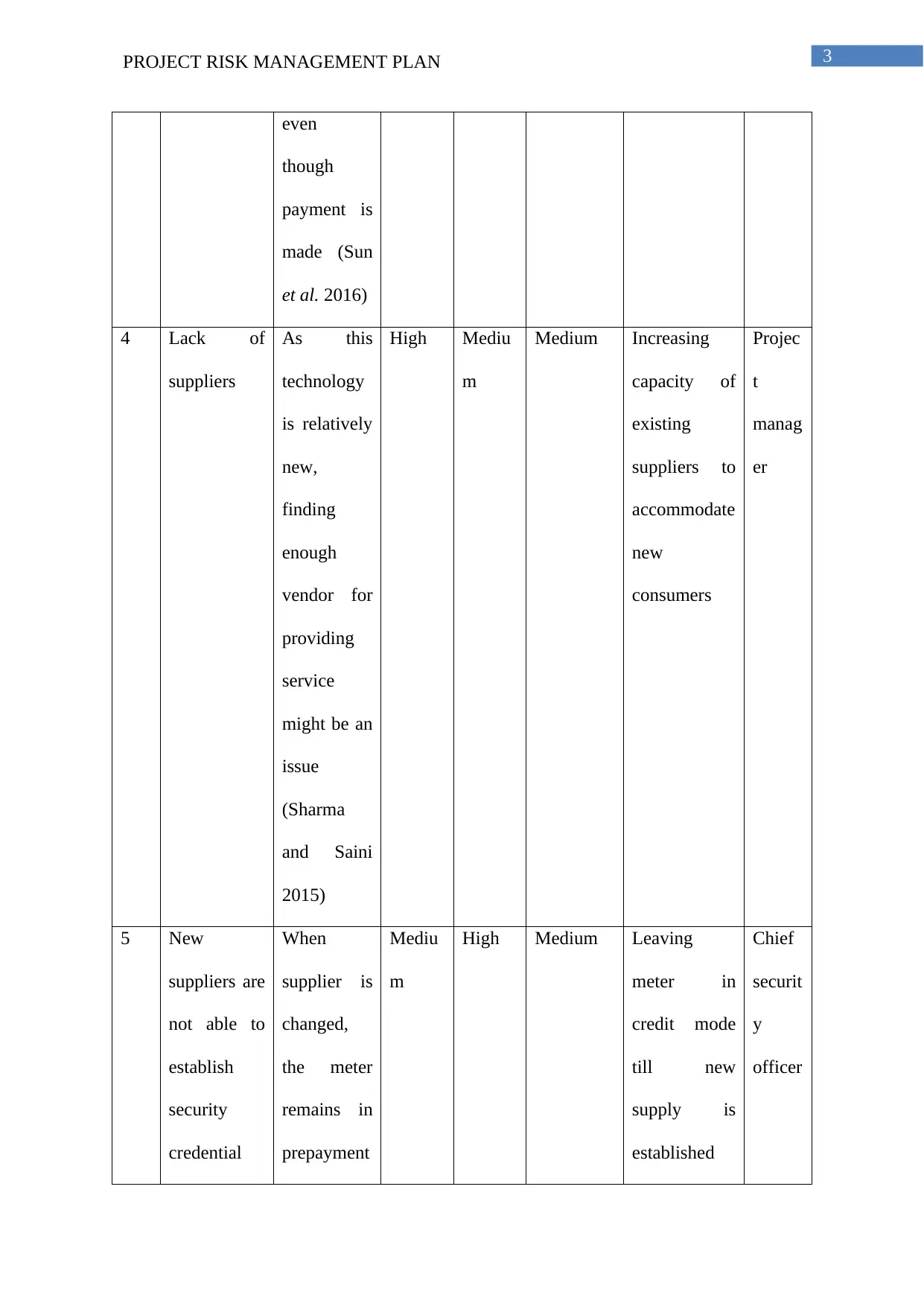
3PROJECT RISK MANAGEMENT PLAN
even
though
payment is
made (Sun
et al. 2016)
4 Lack of
suppliers
As this
technology
is relatively
new,
finding
enough
vendor for
providing
service
might be an
issue
(Sharma
and Saini
2015)
High Mediu
m
Medium Increasing
capacity of
existing
suppliers to
accommodate
new
consumers
Projec
t
manag
er
5 New
suppliers are
not able to
establish
security
credential
When
supplier is
changed,
the meter
remains in
prepayment
Mediu
m
High Medium Leaving
meter in
credit mode
till new
supply is
established
Chief
securit
y
officer
even
though
payment is
made (Sun
et al. 2016)
4 Lack of
suppliers
As this
technology
is relatively
new,
finding
enough
vendor for
providing
service
might be an
issue
(Sharma
and Saini
2015)
High Mediu
m
Medium Increasing
capacity of
existing
suppliers to
accommodate
new
consumers
Projec
t
manag
er
5 New
suppliers are
not able to
establish
security
credential
When
supplier is
changed,
the meter
remains in
prepayment
Mediu
m
High Medium Leaving
meter in
credit mode
till new
supply is
established
Chief
securit
y
officer
Paraphrase This Document
Need a fresh take? Get an instant paraphrase of this document with our AI Paraphraser
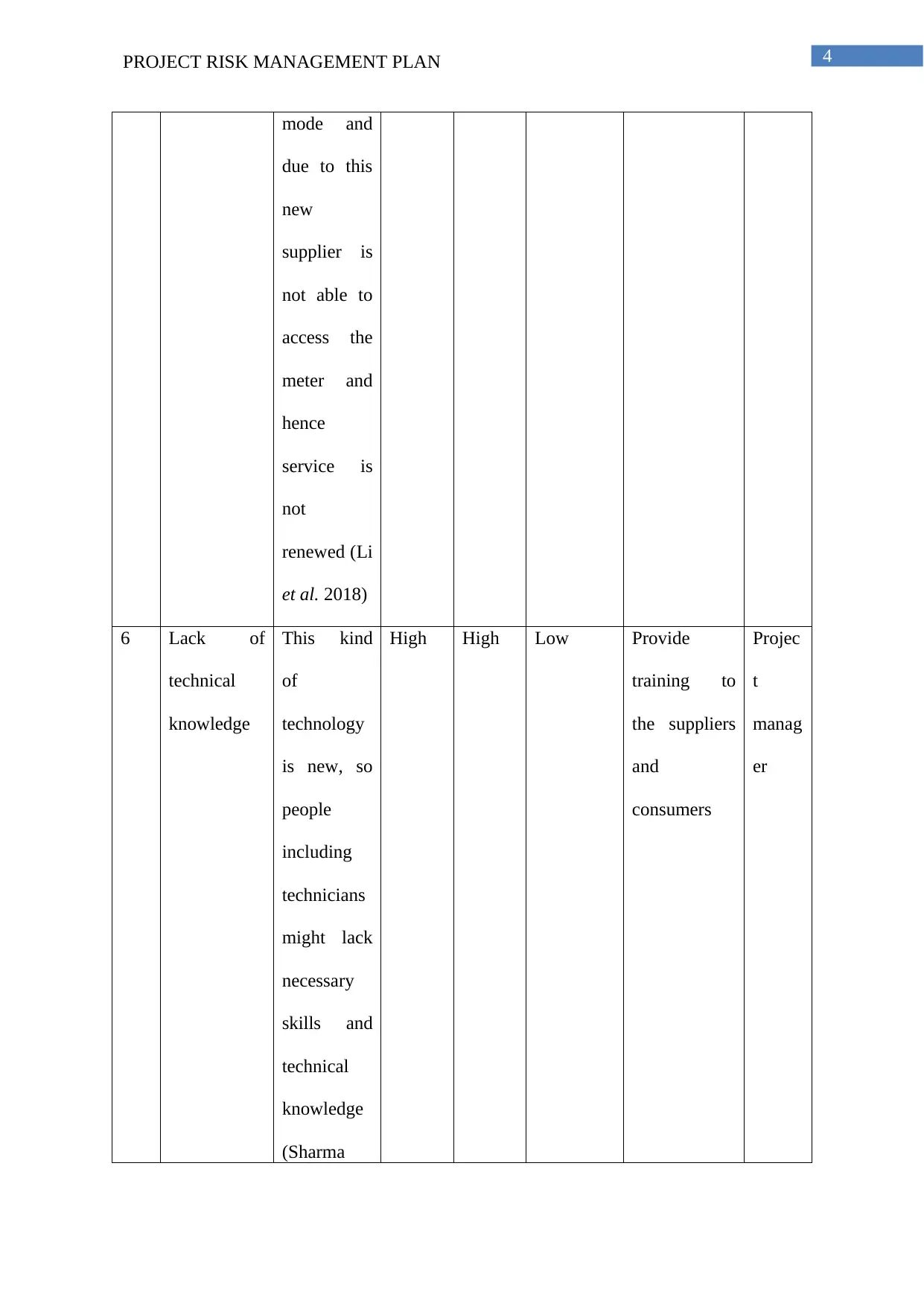
4PROJECT RISK MANAGEMENT PLAN
mode and
due to this
new
supplier is
not able to
access the
meter and
hence
service is
not
renewed (Li
et al. 2018)
6 Lack of
technical
knowledge
This kind
of
technology
is new, so
people
including
technicians
might lack
necessary
skills and
technical
knowledge
(Sharma
High High Low Provide
training to
the suppliers
and
consumers
Projec
t
manag
er
mode and
due to this
new
supplier is
not able to
access the
meter and
hence
service is
not
renewed (Li
et al. 2018)
6 Lack of
technical
knowledge
This kind
of
technology
is new, so
people
including
technicians
might lack
necessary
skills and
technical
knowledge
(Sharma
High High Low Provide
training to
the suppliers
and
consumers
Projec
t
manag
er

5PROJECT RISK MANAGEMENT PLAN
and Saini
2015)
7 Data hack As payment
is made
through
entering
code into
the smart
meter, there
is always
chance for
hack of
these data
for
tempering
with the
system
making
service less
reliable and
consistent
(Esteves et
al. 2016)
High High Medium Encrypting
payment
related data,
thus making
it difficult to
access these
data without
authorization
Chief
securit
y
officer
8 Notification
provided to
Due to
technical
High Low Low Providing
Option to
Chief
techni
and Saini
2015)
7 Data hack As payment
is made
through
entering
code into
the smart
meter, there
is always
chance for
hack of
these data
for
tempering
with the
system
making
service less
reliable and
consistent
(Esteves et
al. 2016)
High High Medium Encrypting
payment
related data,
thus making
it difficult to
access these
data without
authorization
Chief
securit
y
officer
8 Notification
provided to
Due to
technical
High Low Low Providing
Option to
Chief
techni
⊘ This is a preview!⊘
Do you want full access?
Subscribe today to unlock all pages.

Trusted by 1+ million students worldwide
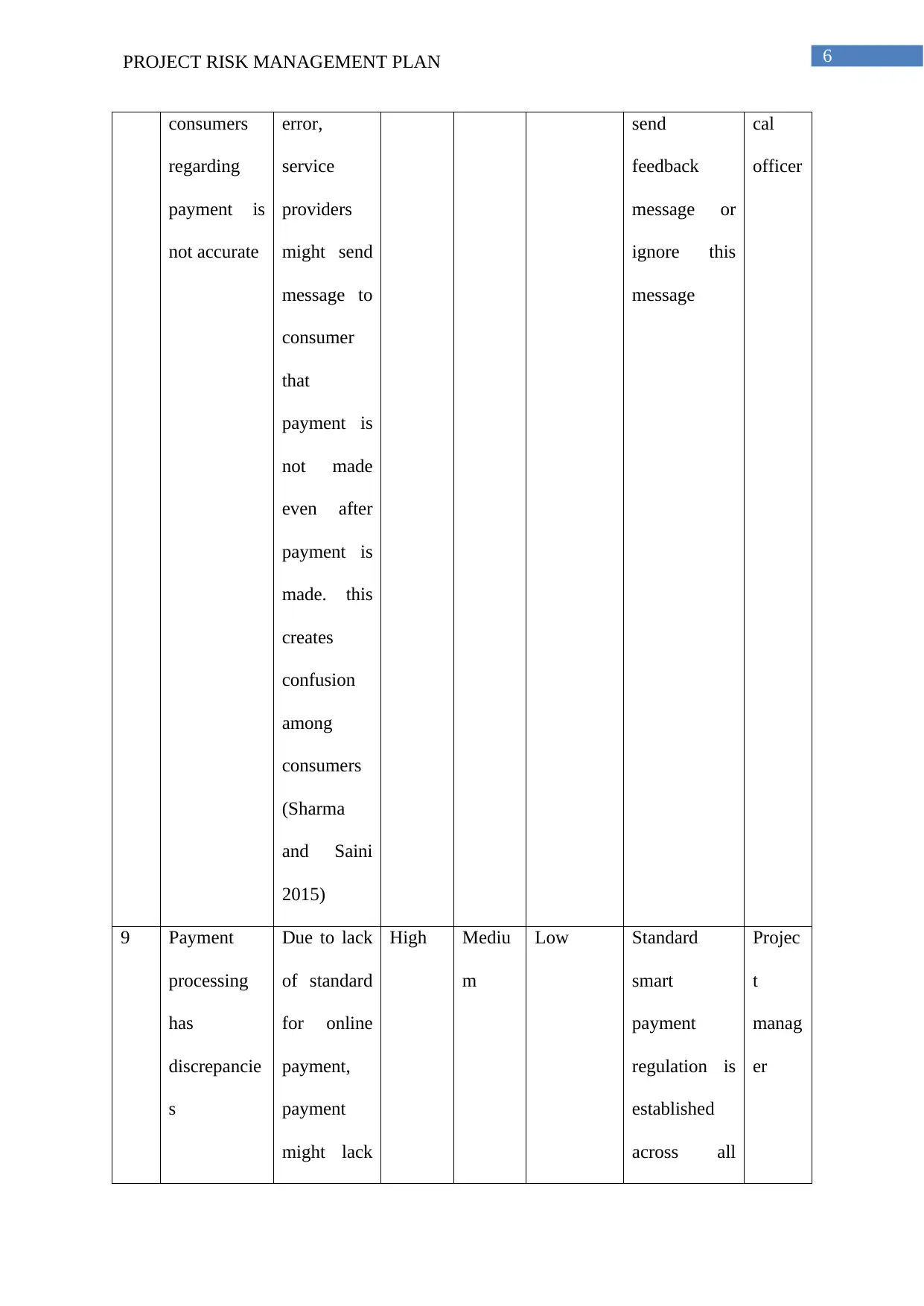
6PROJECT RISK MANAGEMENT PLAN
consumers
regarding
payment is
not accurate
error,
service
providers
might send
message to
consumer
that
payment is
not made
even after
payment is
made. this
creates
confusion
among
consumers
(Sharma
and Saini
2015)
send
feedback
message or
ignore this
message
cal
officer
9 Payment
processing
has
discrepancie
s
Due to lack
of standard
for online
payment,
payment
might lack
High Mediu
m
Low Standard
smart
payment
regulation is
established
across all
Projec
t
manag
er
consumers
regarding
payment is
not accurate
error,
service
providers
might send
message to
consumer
that
payment is
not made
even after
payment is
made. this
creates
confusion
among
consumers
(Sharma
and Saini
2015)
send
feedback
message or
ignore this
message
cal
officer
9 Payment
processing
has
discrepancie
s
Due to lack
of standard
for online
payment,
payment
might lack
High Mediu
m
Low Standard
smart
payment
regulation is
established
across all
Projec
t
manag
er
Paraphrase This Document
Need a fresh take? Get an instant paraphrase of this document with our AI Paraphraser

7PROJECT RISK MANAGEMENT PLAN
consistency
depending
on the
service
providers
(Li et al.
2018)
service points
for payment
processing
consistency
depending
on the
service
providers
(Li et al.
2018)
service points
for payment
processing
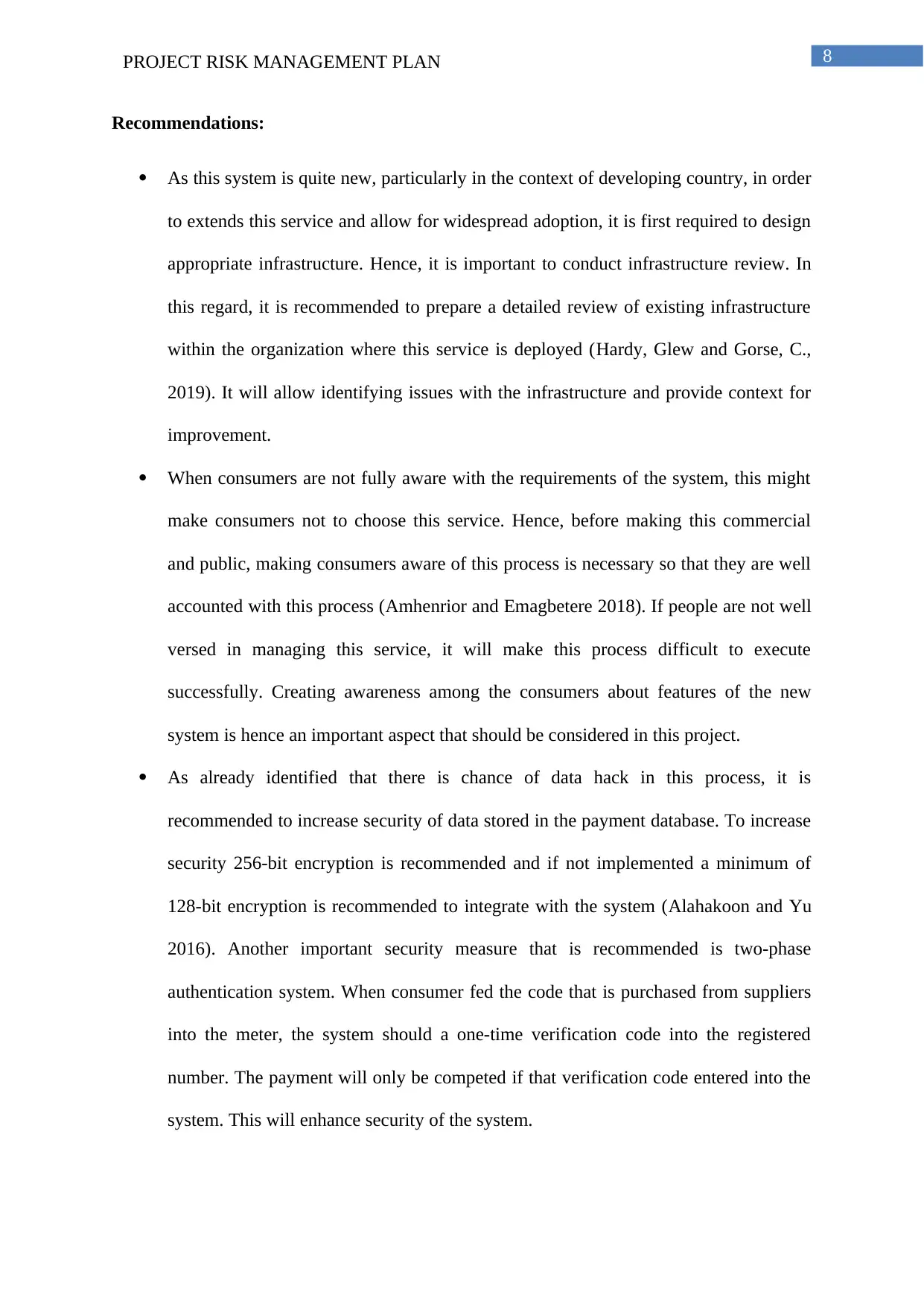
8PROJECT RISK MANAGEMENT PLAN
Recommendations:
As this system is quite new, particularly in the context of developing country, in order
to extends this service and allow for widespread adoption, it is first required to design
appropriate infrastructure. Hence, it is important to conduct infrastructure review. In
this regard, it is recommended to prepare a detailed review of existing infrastructure
within the organization where this service is deployed (Hardy, Glew and Gorse, C.,
2019). It will allow identifying issues with the infrastructure and provide context for
improvement.
When consumers are not fully aware with the requirements of the system, this might
make consumers not to choose this service. Hence, before making this commercial
and public, making consumers aware of this process is necessary so that they are well
accounted with this process (Amhenrior and Emagbetere 2018). If people are not well
versed in managing this service, it will make this process difficult to execute
successfully. Creating awareness among the consumers about features of the new
system is hence an important aspect that should be considered in this project.
As already identified that there is chance of data hack in this process, it is
recommended to increase security of data stored in the payment database. To increase
security 256-bit encryption is recommended and if not implemented a minimum of
128-bit encryption is recommended to integrate with the system (Alahakoon and Yu
2016). Another important security measure that is recommended is two-phase
authentication system. When consumer fed the code that is purchased from suppliers
into the meter, the system should a one-time verification code into the registered
number. The payment will only be competed if that verification code entered into the
system. This will enhance security of the system.
Recommendations:
As this system is quite new, particularly in the context of developing country, in order
to extends this service and allow for widespread adoption, it is first required to design
appropriate infrastructure. Hence, it is important to conduct infrastructure review. In
this regard, it is recommended to prepare a detailed review of existing infrastructure
within the organization where this service is deployed (Hardy, Glew and Gorse, C.,
2019). It will allow identifying issues with the infrastructure and provide context for
improvement.
When consumers are not fully aware with the requirements of the system, this might
make consumers not to choose this service. Hence, before making this commercial
and public, making consumers aware of this process is necessary so that they are well
accounted with this process (Amhenrior and Emagbetere 2018). If people are not well
versed in managing this service, it will make this process difficult to execute
successfully. Creating awareness among the consumers about features of the new
system is hence an important aspect that should be considered in this project.
As already identified that there is chance of data hack in this process, it is
recommended to increase security of data stored in the payment database. To increase
security 256-bit encryption is recommended and if not implemented a minimum of
128-bit encryption is recommended to integrate with the system (Alahakoon and Yu
2016). Another important security measure that is recommended is two-phase
authentication system. When consumer fed the code that is purchased from suppliers
into the meter, the system should a one-time verification code into the registered
number. The payment will only be competed if that verification code entered into the
system. This will enhance security of the system.
⊘ This is a preview!⊘
Do you want full access?
Subscribe today to unlock all pages.

Trusted by 1+ million students worldwide
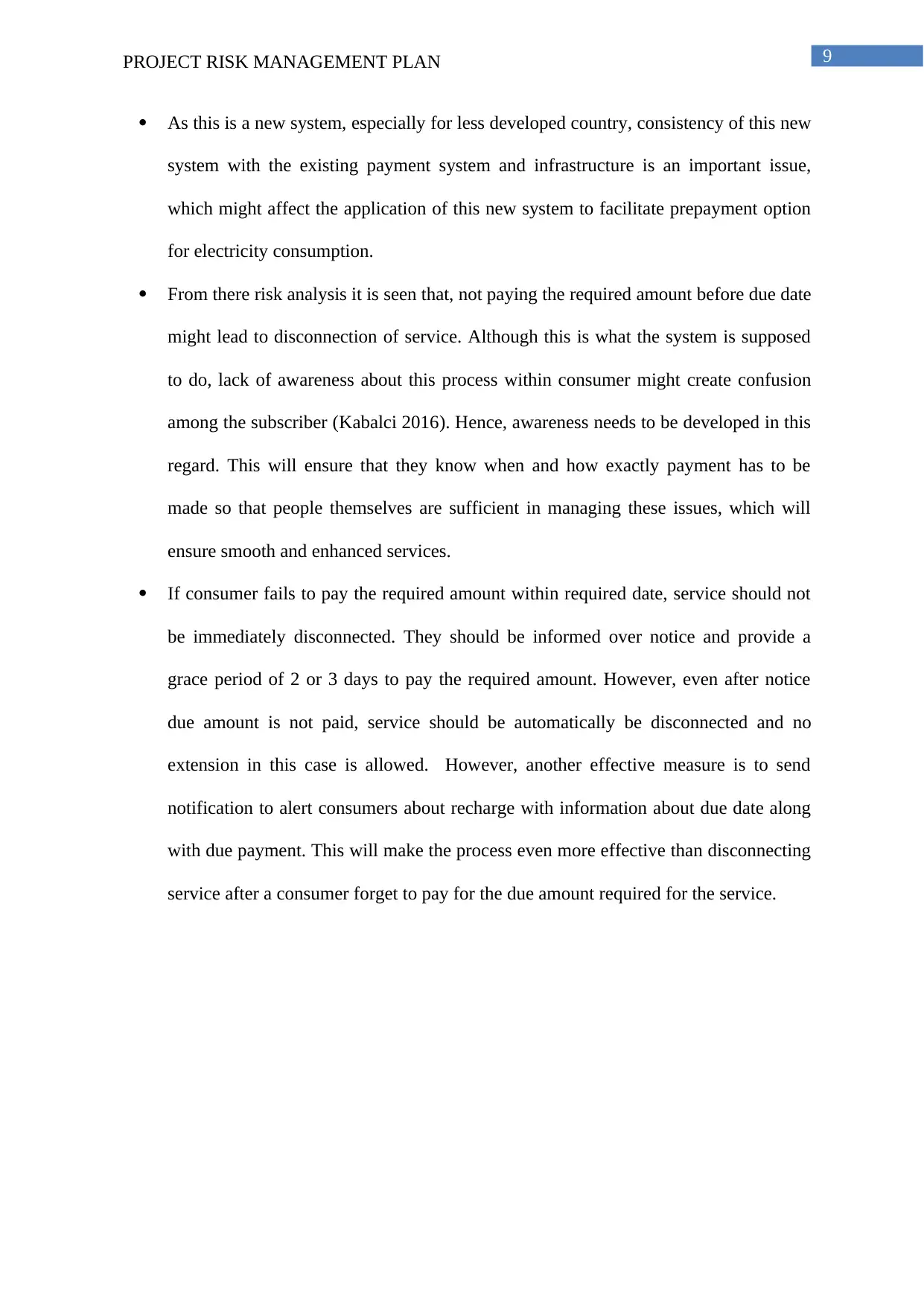
9PROJECT RISK MANAGEMENT PLAN
As this is a new system, especially for less developed country, consistency of this new
system with the existing payment system and infrastructure is an important issue,
which might affect the application of this new system to facilitate prepayment option
for electricity consumption.
From there risk analysis it is seen that, not paying the required amount before due date
might lead to disconnection of service. Although this is what the system is supposed
to do, lack of awareness about this process within consumer might create confusion
among the subscriber (Kabalci 2016). Hence, awareness needs to be developed in this
regard. This will ensure that they know when and how exactly payment has to be
made so that people themselves are sufficient in managing these issues, which will
ensure smooth and enhanced services.
If consumer fails to pay the required amount within required date, service should not
be immediately disconnected. They should be informed over notice and provide a
grace period of 2 or 3 days to pay the required amount. However, even after notice
due amount is not paid, service should be automatically be disconnected and no
extension in this case is allowed. However, another effective measure is to send
notification to alert consumers about recharge with information about due date along
with due payment. This will make the process even more effective than disconnecting
service after a consumer forget to pay for the due amount required for the service.
As this is a new system, especially for less developed country, consistency of this new
system with the existing payment system and infrastructure is an important issue,
which might affect the application of this new system to facilitate prepayment option
for electricity consumption.
From there risk analysis it is seen that, not paying the required amount before due date
might lead to disconnection of service. Although this is what the system is supposed
to do, lack of awareness about this process within consumer might create confusion
among the subscriber (Kabalci 2016). Hence, awareness needs to be developed in this
regard. This will ensure that they know when and how exactly payment has to be
made so that people themselves are sufficient in managing these issues, which will
ensure smooth and enhanced services.
If consumer fails to pay the required amount within required date, service should not
be immediately disconnected. They should be informed over notice and provide a
grace period of 2 or 3 days to pay the required amount. However, even after notice
due amount is not paid, service should be automatically be disconnected and no
extension in this case is allowed. However, another effective measure is to send
notification to alert consumers about recharge with information about due date along
with due payment. This will make the process even more effective than disconnecting
service after a consumer forget to pay for the due amount required for the service.
Paraphrase This Document
Need a fresh take? Get an instant paraphrase of this document with our AI Paraphraser
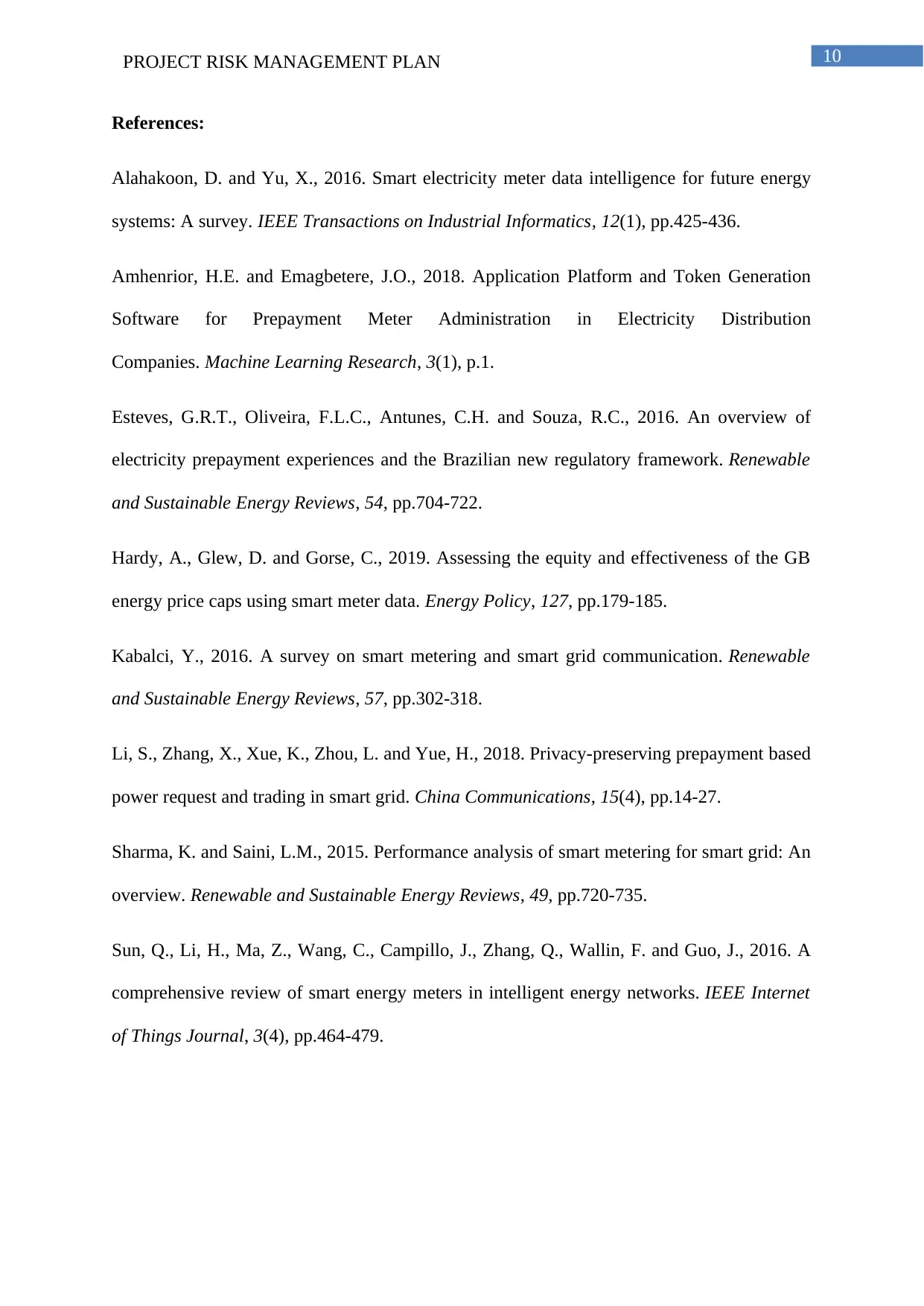
10PROJECT RISK MANAGEMENT PLAN
References:
Alahakoon, D. and Yu, X., 2016. Smart electricity meter data intelligence for future energy
systems: A survey. IEEE Transactions on Industrial Informatics, 12(1), pp.425-436.
Amhenrior, H.E. and Emagbetere, J.O., 2018. Application Platform and Token Generation
Software for Prepayment Meter Administration in Electricity Distribution
Companies. Machine Learning Research, 3(1), p.1.
Esteves, G.R.T., Oliveira, F.L.C., Antunes, C.H. and Souza, R.C., 2016. An overview of
electricity prepayment experiences and the Brazilian new regulatory framework. Renewable
and Sustainable Energy Reviews, 54, pp.704-722.
Hardy, A., Glew, D. and Gorse, C., 2019. Assessing the equity and effectiveness of the GB
energy price caps using smart meter data. Energy Policy, 127, pp.179-185.
Kabalci, Y., 2016. A survey on smart metering and smart grid communication. Renewable
and Sustainable Energy Reviews, 57, pp.302-318.
Li, S., Zhang, X., Xue, K., Zhou, L. and Yue, H., 2018. Privacy-preserving prepayment based
power request and trading in smart grid. China Communications, 15(4), pp.14-27.
Sharma, K. and Saini, L.M., 2015. Performance analysis of smart metering for smart grid: An
overview. Renewable and Sustainable Energy Reviews, 49, pp.720-735.
Sun, Q., Li, H., Ma, Z., Wang, C., Campillo, J., Zhang, Q., Wallin, F. and Guo, J., 2016. A
comprehensive review of smart energy meters in intelligent energy networks. IEEE Internet
of Things Journal, 3(4), pp.464-479.
References:
Alahakoon, D. and Yu, X., 2016. Smart electricity meter data intelligence for future energy
systems: A survey. IEEE Transactions on Industrial Informatics, 12(1), pp.425-436.
Amhenrior, H.E. and Emagbetere, J.O., 2018. Application Platform and Token Generation
Software for Prepayment Meter Administration in Electricity Distribution
Companies. Machine Learning Research, 3(1), p.1.
Esteves, G.R.T., Oliveira, F.L.C., Antunes, C.H. and Souza, R.C., 2016. An overview of
electricity prepayment experiences and the Brazilian new regulatory framework. Renewable
and Sustainable Energy Reviews, 54, pp.704-722.
Hardy, A., Glew, D. and Gorse, C., 2019. Assessing the equity and effectiveness of the GB
energy price caps using smart meter data. Energy Policy, 127, pp.179-185.
Kabalci, Y., 2016. A survey on smart metering and smart grid communication. Renewable
and Sustainable Energy Reviews, 57, pp.302-318.
Li, S., Zhang, X., Xue, K., Zhou, L. and Yue, H., 2018. Privacy-preserving prepayment based
power request and trading in smart grid. China Communications, 15(4), pp.14-27.
Sharma, K. and Saini, L.M., 2015. Performance analysis of smart metering for smart grid: An
overview. Renewable and Sustainable Energy Reviews, 49, pp.720-735.
Sun, Q., Li, H., Ma, Z., Wang, C., Campillo, J., Zhang, Q., Wallin, F. and Guo, J., 2016. A
comprehensive review of smart energy meters in intelligent energy networks. IEEE Internet
of Things Journal, 3(4), pp.464-479.
1 out of 11
Your All-in-One AI-Powered Toolkit for Academic Success.
+13062052269
info@desklib.com
Available 24*7 on WhatsApp / Email
![[object Object]](/_next/static/media/star-bottom.7253800d.svg)
Unlock your academic potential
Copyright © 2020–2026 A2Z Services. All Rights Reserved. Developed and managed by ZUCOL.
